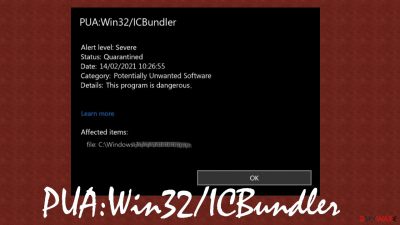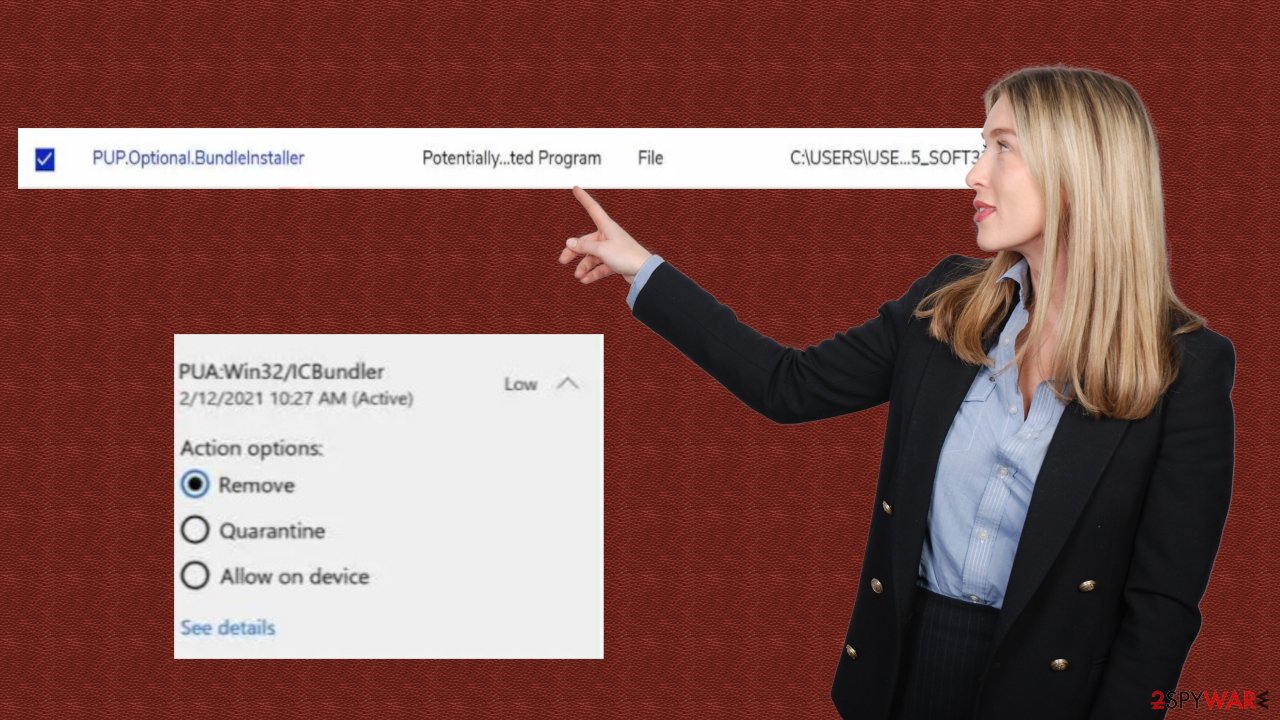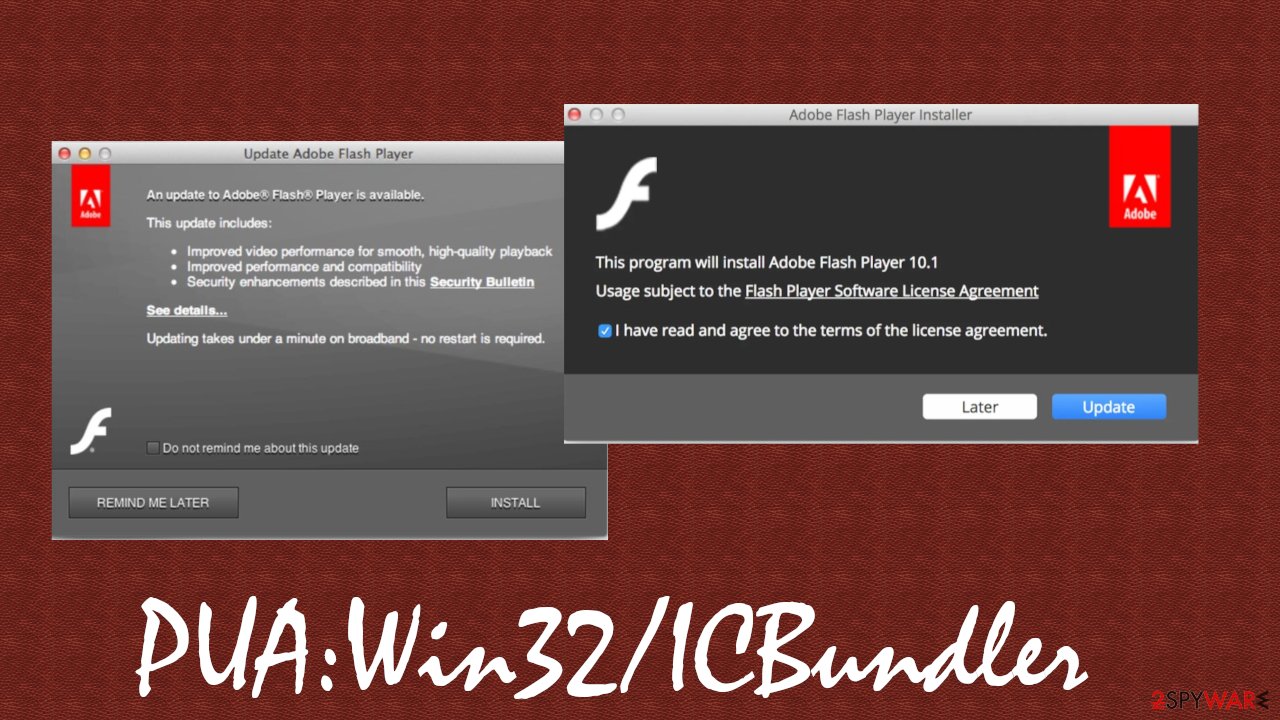PUA:Win32/ICBundler (Virus Removal Guide) - Free Instructions
PUA:Win32/ICBundler Removal Guide
What is PUA:Win32/ICBundler?
PUA:Win32/ICBundler – a detection name indicating the intrusive adware infection

PUA:Win32/ICBundler is a potentially unwanted program (PUP) that could cause installations of other PUPs, display irritating ads, cause sudden redirects to questionable portals, and record browsing habits. This type of software is usually installed with freeware bundles or through deceptive ads.
PUA:Win32/ICBundler ads could be displayed as pop-ups, banners, in-text hyperlinks, sponsored search results, and so on. This mainly affects Google Chrome, Mozilla Firefox, MS Edge browsers, but that doesn't mean that others are safe. Deceptive ads might lead to privacy loss, more infections with PUPs, and other uncomfortable situations.
Furthermore, this adware can cause redirections to affiliated sites with inappropriate or malicious content. Although PUPs aren't considered as hazardous as malware, they can still cause nightmares. This article will inform you of its dangers, distribution techniques, and removal methods.
| name | PUA:Win32/ICBundler |
|---|---|
| Type | Adware, redirect virus, PUP |
| Symptoms | More than usual ads than cause redirects to dubious portals, sudden redirects to suspicious sites, slower device performance |
| Risks | Installation of other potentially unwanted programs, intrusive ads and redirects might lead to portals with malware, privacy loss |
| Distribution | Freeware bundles, deceptive ads, fake Flash installers/updaters |
| Removal | Like any other PUPs or malware, this ICBundler intruder should be eliminated with dependable anti-malware software |
| System repair | Computer infections make alterations to system files/settings that may lead to crashing, lag, freezing, BSoD,[1] etc. Repair any issues and clean up your device with the powerful FortectIntego system tune-up tool |
There's a lot of potentially unwanted programs that could harshly impede your browsing experience and device performance. Two of the most popular ones are adware and browser hijackers. The latter causes redirects and alters browser settings to promote an affiliated search engine and show ads as search results.
Adware operates similarly, although it doesn't change any browser settings. It shows tons of deceptive ads that redirect you to malicious pages where private details might be drawn out, other PUPs pushed to install, and so on. The same goes for PUA:Win32/ICBundler ads.
A pop-up, banner, or another form of ICBundler ad might attract your attention by displaying imaginary breaking news, an amazing deal, or other catchy content. If it's clicked on, you can be redirected to websites with explicit, malevolent, or other shady content, including:
- gambling,
- porn,
- fake updates,
- useless apps,
- tech support scams,
- gaming,
- etc.
Therefore, ads by PUA:Win32/ICBundler should never be clicked. Sometimes, users might be redirected to pages without even clicking on anything. That's how adware operators generate revenue by forwarding you to dubious affiliated websites. This PUP or related third-party advertisers can collect and track information about your online habits.

You can encounter this ICBundler PUP detection out of nowhere, so many questions should go to your head. It is possible that the intruder is not affecting anything on the machine at the time you notice this suspicious piece or your AV tool indicates a possible risk. You should rely on the security tool that you use or a different app to avoid any PUP damage that might occur over time since adware is a silent infection.
Hence, you have to remove PUA:Win32/ICBundler from any infected device immediately. Although Windows defender could take care of that, we advise our readers to acquire a professional anti-malware tool such as SpyHunter 5Combo Cleaner or Malwarebytes that would protect their every step and prevent all kinds of malware[2] from infecting their devices.
It's a well-known fact that computer infections cause damage to system files and settings. If left unattended, these modifications lead to various abnormal device behavior. Following PUA:Win32/ICBundler removal, cybersecurity experts[3] highly recommend using an all-in-one FortectIntego system tune-up tool to repair any damage the computer system sustained and clean it up.
Software bundles, deceptive ads, fake Flash updaters are among the most popular PUP distribution methods
We've all encountered misleading ads in our lives. They might portray some amazing deal but you get redirected to a page that has nothing in common with the ad itself. Deceptive ads usually advertise various PUPs as tools that would improve certain device aspects, boost internet speed, or other non-sense.
When in reality they will do no such things, or the exact opposite by slowing down your device and showing tons of other ads. Fake Flash installers could also be categorized as deceptive as instead of updates, users get a worthless piece of software that impedes their browsing activities.

PUPs are also sneakily delivered with software bundles. The trick behind this is that all apps in the pack are preselected for installation. Therefore, if you ever want an app from a bundle please take your time and pick the Custom or Advanced installation mode over the Recommended/Quick/Standard one.
Simple directions for PUA:Win32/ICBundler removal from affected Windows devices
PUA:Win32/ICBundler virus is detectable by Windows Defender, security applications, or different anti-malware tools. The software from Microsoft is great and it's free but cybercriminals are constantly evolving their creations. Thus we recommend acquiring professional anti-malware software for double-checking and proper system cleaning.
To safely remove PUA:Win32/ICBundler and any other PUPs, malware, and suspicious entries launch your security tool and perform a full system scan. Once the scan is finished and all the threats accounted for, stick to the security software recommendations on how to proceed further.
After PUA:Win32/ICBundler removal you should use one more tool to repair any damage that your computer system settings and files sustained during the infection. Use an all-in-one system optimizer to fix any system irregularities and wipe tracking cookies and other browser-related data.
You may remove virus damage with a help of FortectIntego. SpyHunter 5Combo Cleaner and Malwarebytes are recommended to detect potentially unwanted programs and viruses with all their files and registry entries that are related to them.
Getting rid of PUA:Win32/ICBundler. Follow these steps
Uninstall from Windows
Instructions for Windows 10/8 machines:
- Enter Control Panel into Windows search box and hit Enter or click on the search result.
- Under Programs, select Uninstall a program.

- From the list, find the entry of the suspicious program.
- Right-click on the application and select Uninstall.
- If User Account Control shows up, click Yes.
- Wait till uninstallation process is complete and click OK.

If you are Windows 7/XP user, proceed with the following instructions:
- Click on Windows Start > Control Panel located on the right pane (if you are Windows XP user, click on Add/Remove Programs).
- In Control Panel, select Programs > Uninstall a program.

- Pick the unwanted application by clicking on it once.
- At the top, click Uninstall/Change.
- In the confirmation prompt, pick Yes.
- Click OK once the removal process is finished.
Delete from macOS
Remove items from Applications folder:
- From the menu bar, select Go > Applications.
- In the Applications folder, look for all related entries.
- Click on the app and drag it to Trash (or right-click and pick Move to Trash)

To fully remove an unwanted app, you need to access Application Support, LaunchAgents, and LaunchDaemons folders and delete relevant files:
- Select Go > Go to Folder.
- Enter /Library/Application Support and click Go or press Enter.
- In the Application Support folder, look for any dubious entries and then delete them.
- Now enter /Library/LaunchAgents and /Library/LaunchDaemons folders the same way and terminate all the related .plist files.

Remove from Microsoft Edge
Delete unwanted extensions from MS Edge:
- Select Menu (three horizontal dots at the top-right of the browser window) and pick Extensions.
- From the list, pick the extension and click on the Gear icon.
- Click on Uninstall at the bottom.

Clear cookies and other browser data:
- Click on the Menu (three horizontal dots at the top-right of the browser window) and select Privacy & security.
- Under Clear browsing data, pick Choose what to clear.
- Select everything (apart from passwords, although you might want to include Media licenses as well, if applicable) and click on Clear.

Restore new tab and homepage settings:
- Click the menu icon and choose Settings.
- Then find On startup section.
- Click Disable if you found any suspicious domain.
Reset MS Edge if the above steps did not work:
- Press on Ctrl + Shift + Esc to open Task Manager.
- Click on More details arrow at the bottom of the window.
- Select Details tab.
- Now scroll down and locate every entry with Microsoft Edge name in it. Right-click on each of them and select End Task to stop MS Edge from running.

If this solution failed to help you, you need to use an advanced Edge reset method. Note that you need to backup your data before proceeding.
- Find the following folder on your computer: C:\\Users\\%username%\\AppData\\Local\\Packages\\Microsoft.MicrosoftEdge_8wekyb3d8bbwe.
- Press Ctrl + A on your keyboard to select all folders.
- Right-click on them and pick Delete

- Now right-click on the Start button and pick Windows PowerShell (Admin).
- When the new window opens, copy and paste the following command, and then press Enter:
Get-AppXPackage -AllUsers -Name Microsoft.MicrosoftEdge | Foreach {Add-AppxPackage -DisableDevelopmentMode -Register “$($_.InstallLocation)\\AppXManifest.xml” -Verbose

Instructions for Chromium-based Edge
Delete extensions from MS Edge (Chromium):
- Open Edge and click select Settings > Extensions.
- Delete unwanted extensions by clicking Remove.

Clear cache and site data:
- Click on Menu and go to Settings.
- Select Privacy, search and services.
- Under Clear browsing data, pick Choose what to clear.
- Under Time range, pick All time.
- Select Clear now.

Reset Chromium-based MS Edge:
- Click on Menu and select Settings.
- On the left side, pick Reset settings.
- Select Restore settings to their default values.
- Confirm with Reset.

Remove from Mozilla Firefox (FF)
Remove dangerous extensions:
- Open Mozilla Firefox browser and click on the Menu (three horizontal lines at the top-right of the window).
- Select Add-ons.
- In here, select unwanted plugin and click Remove.

Reset the homepage:
- Click three horizontal lines at the top right corner to open the menu.
- Choose Options.
- Under Home options, enter your preferred site that will open every time you newly open the Mozilla Firefox.
Clear cookies and site data:
- Click Menu and pick Settings.
- Go to Privacy & Security section.
- Scroll down to locate Cookies and Site Data.
- Click on Clear Data…
- Select Cookies and Site Data, as well as Cached Web Content and press Clear.

Reset Mozilla Firefox
If clearing the browser as explained above did not help, reset Mozilla Firefox:
- Open Mozilla Firefox browser and click the Menu.
- Go to Help and then choose Troubleshooting Information.

- Under Give Firefox a tune up section, click on Refresh Firefox…
- Once the pop-up shows up, confirm the action by pressing on Refresh Firefox.

Remove from Google Chrome
Delete malicious extensions from Google Chrome:
- Open Google Chrome, click on the Menu (three vertical dots at the top-right corner) and select More tools > Extensions.
- In the newly opened window, you will see all the installed extensions. Uninstall all the suspicious plugins that might be related to the unwanted program by clicking Remove.

Clear cache and web data from Chrome:
- Click on Menu and pick Settings.
- Under Privacy and security, select Clear browsing data.
- Select Browsing history, Cookies and other site data, as well as Cached images and files.
- Click Clear data.

Change your homepage:
- Click menu and choose Settings.
- Look for a suspicious site in the On startup section.
- Click on Open a specific or set of pages and click on three dots to find the Remove option.
Reset Google Chrome:
If the previous methods did not help you, reset Google Chrome to eliminate all the unwanted components:
- Click on Menu and select Settings.
- In the Settings, scroll down and click Advanced.
- Scroll down and locate Reset and clean up section.
- Now click Restore settings to their original defaults.
- Confirm with Reset settings.

Delete from Safari
Remove unwanted extensions from Safari:
- Click Safari > Preferences…
- In the new window, pick Extensions.
- Select the unwanted extension and select Uninstall.

Clear cookies and other website data from Safari:
- Click Safari > Clear History…
- From the drop-down menu under Clear, pick all history.
- Confirm with Clear History.

Reset Safari if the above-mentioned steps did not help you:
- Click Safari > Preferences…
- Go to Advanced tab.
- Tick the Show Develop menu in menu bar.
- From the menu bar, click Develop, and then select Empty Caches.

After uninstalling this potentially unwanted program (PUP) and fixing each of your web browsers, we recommend you to scan your PC system with a reputable anti-spyware. This will help you to get rid of PUA:Win32/ICBundler registry traces and will also identify related parasites or possible malware infections on your computer. For that you can use our top-rated malware remover: FortectIntego, SpyHunter 5Combo Cleaner or Malwarebytes.
How to prevent from getting adware
Choose a proper web browser and improve your safety with a VPN tool
Online spying has got momentum in recent years and people are getting more and more interested in how to protect their privacy online. One of the basic means to add a layer of security – choose the most private and secure web browser. Although web browsers can't grant full privacy protection and security, some of them are much better at sandboxing, HTTPS upgrading, active content blocking, tracking blocking, phishing protection, and similar privacy-oriented features. However, if you want true anonymity, we suggest you employ a powerful Private Internet Access VPN – it can encrypt all the traffic that comes and goes out of your computer, preventing tracking completely.
Lost your files? Use data recovery software
While some files located on any computer are replaceable or useless, others can be extremely valuable. Family photos, work documents, school projects – these are types of files that we don't want to lose. Unfortunately, there are many ways how unexpected data loss can occur: power cuts, Blue Screen of Death errors, hardware failures, crypto-malware attack, or even accidental deletion.
To ensure that all the files remain intact, you should prepare regular data backups. You can choose cloud-based or physical copies you could restore from later in case of a disaster. If your backups were lost as well or you never bothered to prepare any, Data Recovery Pro can be your only hope to retrieve your invaluable files.























